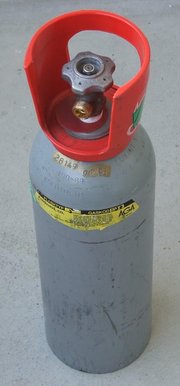Difference between revisions of "CO2 tank"
(→Bulk tanks) |
(→Bulk tanks: +fittings, usage) |
||
| Line 18: | Line 18: | ||
Bulk tanks come in a variety of sizes, and are sold for use in beer tapping systems, aquariums, welding, as fire extinguishers and more. Empty tanks are either swapped for full ones or refilled for a certain fee. | Bulk tanks come in a variety of sizes, and are sold for use in beer tapping systems, aquariums, welding, as fire extinguishers and more. Empty tanks are either swapped for full ones or refilled for a certain fee. | ||
| − | + | ===Fittings=== | |
| + | |||
| + | In the US and Canada, most CO2 bulk tanks have male CGA 320 threads on the output, this thread is used only for CO2. In Europe the thread is designated as W 21.8 x 1/14", and is identical to that of European oxygen tanks, so O2 regulators can be used on CO2 cylinders if neccessary. | ||
| + | |||
| + | ===Usage=== | ||
| + | |||
| + | Bulk taks can be used as pressure sources directly, or for filling paintball CO2 tanks using a CO2 [[fill station]]. For the latter, a tank with a siphon tube is useful since it will siphon liquid CO2 from the bottom of the tank. When filling from a tank without a siphon, it must be turned upside down to allow liquid CO2 through the valve. Conversely, a tank with a siphon must be turned upside down if it is to be used as a pressure source. CO2 fire extinguishers usually have siphon tubes installed. | ||
Revision as of 22:33, 3 March 2006
CO2 tanks are used as pressure sources for pneumatic launchers. There are two principal kinds, paintball tanks and bulk tanks. In addition there are 12g CO2 cartridges, which are only good for one fill of any sizeable chamber, and usually not cost effective.
The pressure of ~800 psi needs to be regulated down to a pressure suitable for spudguns, using a pressure regulator between the tank and chamber. Regulators are made to connect directly both to paintball and bulk tanks.
Paintball tanks
Paintball tanks come in sizes from 4 to 20 oz, which is the weight of the CO2 the tank can hold. The tank valve is either a pin valve, which is opened by screwing the tank into the fitting, or an on/off valve which can be opened and closed manually. They have a burst disk safety valve that will break and vent the CO2 if the tank pressure rises above a certain limit.
Filling
A paintball tank is usually filled from a bulk tank that has a built-in siphon, which will let out liquid CO2. A paintball fill station is connected to the bulk tank and has the neccessary valves and fittings to connect it to the paintball tank.
The tank needs to be cooled down before filling, the the internal pressure of the tank will then be less than that of the bulk tank, and the pressure will transfer liquid CO2 to the paintball tank. The tank should be weighed when filling, and not filled to a greater weight than the tank is made for. If the tank is filled to excess, the pressure can rize rapidly with increased temperature and rupture the burst disk of the tank. A full tank contains about 1/3 of its volume in liquid CO2.
Bulk tanks
Bulk tanks come in a variety of sizes, and are sold for use in beer tapping systems, aquariums, welding, as fire extinguishers and more. Empty tanks are either swapped for full ones or refilled for a certain fee.
Fittings
In the US and Canada, most CO2 bulk tanks have male CGA 320 threads on the output, this thread is used only for CO2. In Europe the thread is designated as W 21.8 x 1/14", and is identical to that of European oxygen tanks, so O2 regulators can be used on CO2 cylinders if neccessary.
Usage
Bulk taks can be used as pressure sources directly, or for filling paintball CO2 tanks using a CO2 fill station. For the latter, a tank with a siphon tube is useful since it will siphon liquid CO2 from the bottom of the tank. When filling from a tank without a siphon, it must be turned upside down to allow liquid CO2 through the valve. Conversely, a tank with a siphon must be turned upside down if it is to be used as a pressure source. CO2 fire extinguishers usually have siphon tubes installed.
